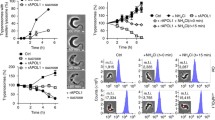Abstract.
The function of the proteins of the apolipoprotein L (apoL) family is largely unknown. These proteins are classically thought to be involved in lipid transport and metabolism, mainly due to the initial discovery that a secreted member of the family, apoL-I, is associated with high-density lipoprotein particles. However, the other members of the family are believed to be intracellular. The recent unravelling of the mechanism by which apoL-I kills African trypanosomes, as well as the increasing evidence for modulation of apoL expression in various pathological processes, provides new insights about the functions of these proteins. ApoLs share structural and functional similarities with proteins of the Bcl-2 family. Based on the activity of apoL-I in trypanosomes and the comparison with Bcl-2 proteins, we propose that apoLs could function as ion channels of intracellular membranes and be involved in mechanisms triggering programmed cell death.
Similar content being viewed by others
Author information
Authors and Affiliations
Corresponding author
Additional information
Received 28 February 2006; received after revision 18 May 2006; accepted 2 June 2006
Rights and permissions
About this article
Cite this article
Vanhollebeke, B., Pays, E. The function of apolipoproteins L. Cell. Mol. Life Sci. 63, 1937–1944 (2006). https://doi.org/10.1007/s00018-006-6091-x
Published:
Issue Date:
DOI: https://doi.org/10.1007/s00018-006-6091-x




